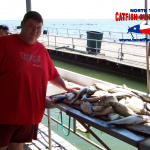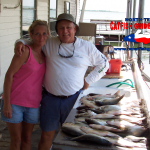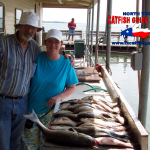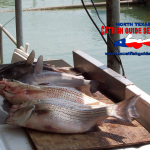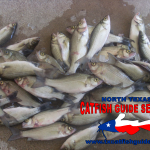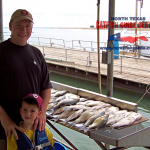While our name does not reflect it, we don’t just fish for catfish! In addition to providing guided fishing trips for catfish, North Texas Catfish Guide Service also provides guided fishing trips for white bass (sandies, sand bass), Hybrid Striped Bass, and Gar in addition to blue catfish, channel catfish and flathead catfish.
White Bass are present in most of the lakes we fish in excellent populations. These fish are known for their abundant populations in North Texas area lakes and well known for their aggressive feeding habits, often found in huge top water schools on the lakes during warmer months in a literal feeding frenzy.
White Bass, or as they are most commonly called in Texas “sandbass” or “sandies” have excellent populations in all the lakes we offer our guided fishing trips on. Lake Lewisville, Eagle Mountain Lake, Lake Worth, the Brazos River and all of the other lakes we fish have excellent populations of these fish.
For fast action and hard pulling during the warmer months hybrid striped bass and sandbass (white bass) are excellent for corporate fishing trips, company fishing trips, family fishing trips or fishing trips for kids.
White bass fishing trips are good for large groups, families and children because there is constant action and little to no waiting to catch fish, if we are not catching fish we are moving to another spot to find fish.
White bass also require little casting or other fishing techniques so they are very easy for the inexperienced fishermen to catch as well.
White bass (sandbass) are also excellent to eat, and we clean your catch at the end of your guided fishing trip with North Texas catfish Guide Service if you choose to keep your fish, or if you want to catch and release we can do that also.
When fishing for white bass and hybrid striped bass we will use a number of different techniques including fishing with slabs (slabbing), lure fishing, live bait fishing, drifting, and trolling.
White bass and hybrid striped bass action is usually excellent during the warmer months from March until late September.
The white bass (sandies, sandbass) and hybrid striped bass (hybrids) do bite in the cooler months, but the bite is less aggressive and the cooler months are typically prime time for catching blue catfish so we stay pretty busy chasing catfish on our guided fishing trips in the cooler months.
What is a Hybrid Striped Bass
A hybrid striped bass, “hybrid” or “hybrid striper” is a cross between a white bass and a striped bass. These fish are stocked in many Texas lakes by Texas Parks and Wildlife.
The techniques used for catching hybrid striped bass are very similar to those used for striper fishing and also similar to the techniques used for fishing for white bass.
The hybrid striped bass however gets much larger than the white bass and is a very aggressive fish. They are a blast to catch and a there is no guessing as to what it is when you have hooking into a big one!
Hybrid striped bass fishing trips are available from June to September on Lake Lewisville.
Information Courtesy of Texas Parks and Wildlife
Sandbass, Sandie, Sand Bass, Bar Fish, Barfish, Streaker, Silver Bass
Morone is of unknown derivation. The species epithet chrysops is Greek meaning “golden eye.” As with other true basses, the dorsal fin is clearly double, separated into spiny and soft-rayed portions. White bass are silvery shading from dark-gray or black on the back to white on the belly. Several incomplete lines or stripes run horizontally on each side of the body. Adults resemble young striped bass, and the two are often confused. However, striped bass have two distinct tooth patches on the back of the tongue, and white bass have one tooth patch. Striped bass have two sharp points on each gill cover, as opposed to white bass which have one, and the second spine on the anal fin is about half the length of the third spine in striped bass, whereas it is about two-thirds the length of the third spine in white bass.
White Bass are active early spring spawners. Schools of males migrate upstream to spawning areas as much as a month before females. There is no nest preparation. Spawning occurs either near the surface, or in midwater. Running water with gravel or rock substrate is preferred. Females rise to the surface and several males crowd around as the eggs and sperm are released. Large females release sometimes nearly a million small eggs during the spawning season. After release eggs sink to the bottom and become attached to rocks, hatching in 2-3, fry grow rapidly feeding on small invertebrates. White bass may grow as many as 8 or 9 inches during the first year. Adults are usually found in schools. Feeding occurs near the surface where fish, crustaceans and emerging insects are found in abundance. Gizzard and Threadfin Shad are the preferred food. White Bass more than 4 years of age are rare.
White bass are native to the central US west of the Appalachians, including the Great Lakes, as well as river systems in the Ohio and Mississippi river valleys. In Texas the species is native to the Red River drainage.
White bass are the fifth most preferred species among licensed Texas anglers. Schools of white bass feeding on shad generate much excitement in the fishing community. Once a school has been located, successful anglers often fish the surface with spoons or spinners. Bottom fishing at night with live bait may also produce great success. White bass are excellent fighters, and are considered superb table fare.
For information on identifying Striped Bass, White Bass, Hybrid Striped Bass, and Yellow Bass view the information below from Texas Parks and Wildlife.
